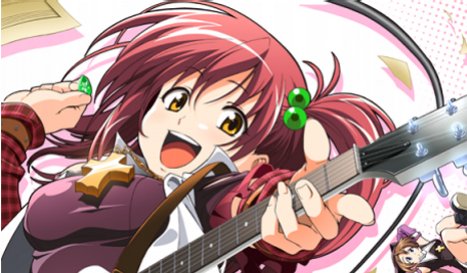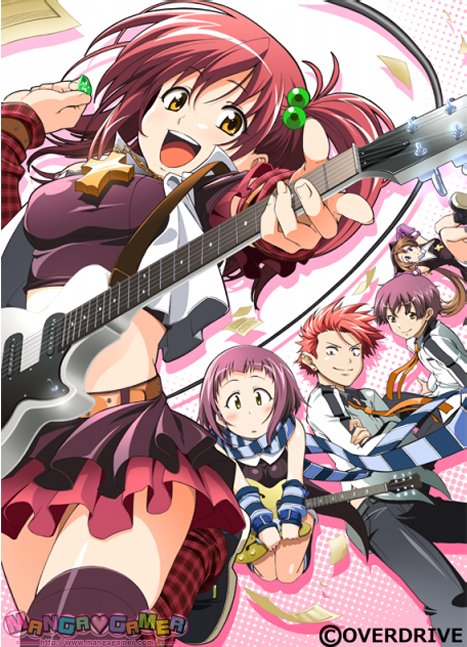Several years have passed since the amateur band Second Literature Club spent a summer touring Japan and performing live. When Shikanosuke and his friends graduated from Oubi Academy, the legends they left behind drew several experienced musicians to seek entry into Oubi Academy. Every year, these excellent musicians seek to join the Girls Light Music Club, which inherited the name of Shikanosuke’s band, and every year they give high quality performances rivaling the original.
The Review!
Artwork:
The benefit to a visual novel is that the game makers can use some animation to make characters expressions clear and also show the environment so that not all of the work in describing a situation needs to come from text. Kira Kira Curtain Call uses animation style backgrounds and while the game adds a few new locations the majority are recycled from the first game. There is no animation for the characters and they are more static 2D characters that look like paper dolls but are interchanged out to reflect dialogue or changes in character emotion. The characters are designed in a way that doesn’t try to pretend they are 3-D but they are drawn with care and attention paid to details and scale. The characters have a small number of outfits that are changed in the story but there are more than just two clothing designs for each of the main characters. There are also a number of poses and facial expressions that get used often though the story though they are switched up often enough and done well enough to convey the emotions that correspond with the events in the novel.
Text:
The text is mostly improved from the original release with spelling having been taken care of but there is an error somewhere in the program that adds question marks on occasion and every great once in awhile it will drop a word. For the most part the errors aren’t frequent nor are they present to a point where the story is lost but there are a few places where the text provides some confusion as to what is going on in regards to the flow of the novel. Thankfully none of the occurrences is at a climactic time and the vast bulk of the novel is rather well done.
Audio:
The audio for this game is also largely recycled background music with a paucity of new musical numbers. The backgrounds are as clear as they were in the first and the songs are still strong when they appear.
Packaging:
The material reviewed was provided as a download so there is no packaging to review.
Menu:
The menus to this release are a basic but mostly intuitive affair. The main menu starts with an image of a crowd in full enjoyment from one of the music performances in the game. The options are Start, Load, Extra, Configure and Exit. Start goes right into the beginning of the game with its beginning at a music house with the music swelling and crowd noise. Load will take you to the save screen (save is detailed later in this section). The extra option will take you to a screen that collects pictures, songs and an event from the game and is unlocked after completing the first part of the game. The CG Gallery looks like a picture album of shots from the game which can be clicked on to enlarge and sometimes change slightly the pictures and Scene Replay collects the sex scene from the game after it has been unlocked and can be clicked on to replay it. Song Library collects the 5 songs from two groups in the game and allows for them to replayed after being unlocked when they happen as well as a track that appears at the end of the game. The configure screen allows the user to customize sound level, effect level, text speed, voice level, the right click option and text skip as well as the game window size. After the first part is completed the screen changes and features a wall with the logos of the bands that feature prominently in the game.
On the game screen itself there are quick buttons in the lower right hand side to either do a quick save or quick load, return to the menu, skip text for game replay to advance thorough text you have progressed past before, auto text so you don’t have to right click and log. Log is useful as it contains the entirety of text from the game so if you miss a point or wish to review something (an added benefit is that if you click on a line you can get the voice actor delivering the line if it was one of their text) though you have to search through as there is no quick search in the log. The save menu allows you to save at almost any line as point (minus a very few points that are short in length) and has space for three quick saves and one hundred regular save which also have the ability to either display the current line of text or that you can create a name for.
Content: (please note that content portions of a review may contain spoilers)
Originally created by Overdrive in 2008 the Japanese version of the game was originally released for the PC and is a follow up to their Kira Kira visual novel. The novel will follow some familiar steps of the original while also breaking out with some brand new characters that approach band life and the dream of following the musical path in their own way and with their own sense of priorities. The setting is a few years after the original game and it will give the player a chance to revisit some familiar places and see a few familiar faces while also seeing what direction their lives have taken and the impact they had on those who follow after them.
Like the first game the sequel begins in a club as the story protagonist Souta Honda is attending a live show though he is probably the least interested person in the club. He watches the reaction of the crowd to a band that a former upper classmen of his has formed and is a bit puzzled by the reaction because he doesn’t get the same sense of excitement they do. He is to meet his friend after the concert and he fears that he will insult the performance by saying what he really thinks. Instead he finds that his friend has changed from the person he knew who was a bit quiet and reserved to a rather braggadocios person but who wants to do his younger friend a favor. Along with the two women in the car they all go to a local hotel where Souta losses his temper when he is expected to have a one night stand. Souta has his own expectations for his life including the type of music he wants to play and his obsession with Yui Yoshimoto, the only woman he loves and he will not compromise when he thinks he is right.
Souta’s biggest challenge outside his propensity to speak his mind without a filter which alienates many around him is that while he may be passionate about music he lacks what many would say is a standout talent. His personality has a tendency to push away everyone around him except his best friend Kazu and Souta finds that his dream of “being like the sun” seems almost as far from him as the actual sun itself. Because of this Souta decides that he will form his own band since the Boys Light Music Club is far less interested in playing at the cultural fair than he is. Souta will set down the road to try to pass the Girl’s Light Music Club which has inherited the title and spirit of the original Second Literature Band. Now with stars in his eyes Souta will try to figure out how to get what he wants out of life-but will his dream of music keep him apart from Yui rather than bring them together? And what happens when life may throw a giant curve ball at his band mate and best friend? How far is Souta willing to go to try to grasp his dream and what is he willing to sacrifice?
The second part of the game follows Murakami’s band Happy Cycle Mania as they are approaching what should be a great moment of celebration of their band and its fifth year anniversary bash but is instead it is looking like the band may be in danger of breaking up instead. There is a good deal of introspecting going on from Murakami as he is starting to look at his life in a way that he had not done before. The band’s popular lead singer Aki has recently left to go professional and Murakami is feeling the weight of being the leader of a band. As he meets with his friend Shikanouske for drinks he starts to compare his life with the one that the former members of the Second Literature Club are leading. Shikanouske has become a salary man at a small company, Chie has become a social worker, Sarina has been put in charge of a few small companies that her grandfather owns make sure she has the skills to one day perhaps take his place and Kirari is singing internationally while keeping a long distance relationship with Shikanouske. Murakami is experiencing a deep sense of ennui and is starting to wonder if maybe his band’s time is up as he has reached the limit of his abilities.
The second stage will mostly follow Murakami as he bounces of the different people in his life-many of them familiar to those who played the first game as well as some characters from the first part of the second game-as his struggles with his own thoughts and feelings will impact those around him and likewise in return. The characters will then be presented with the wall of their dreams and their ideas and they may discover that the biggest thing standing in their own way is the preconceptions they have built up in themselves. The tale may end with a triumph of both music and love as sometimes the breaking of a feeling of doldrums may bring people together or it may end with people deciding to go on a new path but you’ll have to play the game to find out which.
Kira Kira Curtain Call takes the elements from the original game and spins them off into a new area. The protagonist for the first arc is almost the exact opposite of the one from the first game. Souta is a fiery tempered but also driven individual who is rather single minded and his progression gives a bit of stark relief compared to Shikanouske’s fairly characteristic indifference early on and ability to be swayed by events. Souta isn’t as fun a character for me but there is more in him that I identify than with Shikanouske in the original game. The second stage is almost like a mid life crisis and probably one may people can connect with in that its protagonist questions if he has taken the right path in life as he has reached a point where his passion is a bit at ebb and his trials are at high tide. Curtain Call offers a lot of views of the different paths people have taken but it does it in a way that doesn’t try to preach to any one which path to take. Its strength and weakness are the same though in regard to how much of the connection to the story depends both on the original game and in how the game spins the sequel in a different direction using the set up themes. The largely on rails with no branches also can give a bit of a “cramped” feeling as opposed to the illusion of freedom the previous game granted. It is a great follow up in some aspects but if the characters don’t click it just doesn’t have the large cast and accompanying drama to still charm like the original.
The Steamy Side: (Very Spoiler Heavy)
The sex scene starts as Yui knocks Souta to the ground and places her body over his chest and unzips his pant to stare at Souta‘s erect penis. While the scene continues to focus on Yui staring at Souta’s penis they begin to argue over just what roll she gets to have in saying what their relationship. As she is handling his penis he pulls down her shorts and panties and eventually the two virgins get around to giving oral sex to each other. It ends with both having an orgasm and Yui receiving a facial. Souta still has an erection so they are able to have sex so Yui removes her clothes and lies on a desk. Souta pushes he legs up and pushes into her. The two share a bit of a talk while she gets used to the feeling of him being in her as he starts to move and they both start to learn what excites and pleases them. He pulls out as they both orgasm and ejaculates on her body. Yui fears falling asleep assuming Souta will leave her. He claims he won’t but when he thinks she is sleeping he does leave though she sits up as she was not really sleeping and watches him go. It is a scene that both fits and doesn’t as one can see why Yui would feel the way she does and then acts but it also is a scene where the sex could have been replaced by a deep conversation and come to the same place. The only other pseudo scene is one where a couple starts to have sex off screen but is interrupted.
In Summary:
Kira Kira Curtain Call is pretty close to the epitome of an encore. While it is a shorter set that could stand on its own it really gains its momentum and energy by capping what has preceded it. It is different than the original game in that it has no routes to choose from and only a few choices that effect dialogue but it builds on the themes laid out in the original and even the new characters blend into the tapestry that the game created. While the game doesn’t balance as well as a standalone it is an almost perfect addition to the original with the additional exploration of the lives of those who may choose to play music-or those whose drive push them to do so. It is a recommended game for those who loved the first and the change in tone may take a bit of getting use to but the payoff ends on such a strong and emotional chord.
Grade: B







